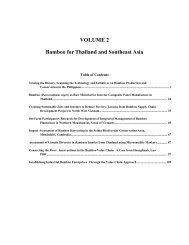WBC-VIII-Vol.4 – Resources – Forestry, Plantations and ... - BambuSC
WBC-VIII-Vol.4 – Resources – Forestry, Plantations and ... - BambuSC
WBC-VIII-Vol.4 – Resources – Forestry, Plantations and ... - BambuSC
You also want an ePaper? Increase the reach of your titles
YUMPU automatically turns print PDFs into web optimized ePapers that Google loves.
Results <strong>and</strong> Discussion<br />
Effects of Bamboo Plantation on Soil Properties<br />
As shown in Table 1, soil pH value decreased with increasing planting time. After the bamboo planted 15 years<br />
soil pH dropped to 3.85 that was almost 2 units lower than that of the paddy soil. Such a result indicated that<br />
bamboo plantation accelerated the soil acidification when using this intensive management model. Soil<br />
acidification is a naturally occurring phenomenon <strong>and</strong> is usually the result of long-term additions of protons to<br />
the upper layers of the soil profile that effectively results in the displacement of exchangeable bases <strong>and</strong> their<br />
subsequent leaching. However, accelerated acidification of soils associated with export of alkali through product<br />
removal, or movement of cations associated with nitrate leaching, has brought into question the long-term<br />
sustainability of crop <strong>and</strong> forage production systems (Helyar 1976). In this study, the accelerated acidification in<br />
a short term exerted an important impact on bamboo sustainable production. When using the organic material<br />
mulching technique, bamboo soils simultaneously received nitrogen fertilizer with a rate of ca. 800 kg N hm -2<br />
annually that accordingly made a direct impact on the soil acidification. Due to acid release in the<br />
decomposition, the mulched organic material also had an impact on soil acidification but no evidence was<br />
obtained up-to-now in the bamboo plantation.<br />
Soil organic matter content increased greatly from 31.0 to 79.2 g kg -1 after 15 years (Table 1). Obviously, the<br />
increase of soil C <strong>and</strong> N (from 2.02 to 4.61 g kg -1 ) was closely related to the input of fertilizer <strong>and</strong> organic<br />
matter. During the first 5 years, soil organic matter <strong>and</strong> nitrogen contents were slightly lower than those in the<br />
control of paddy soils. In the process of paddy field shifted to upl<strong>and</strong>, easily decomposable organic matter<br />
decomposed rapidly due to a better oxidation condition. After the rice straw <strong>and</strong> bran mulching (from the 5 th<br />
year), soil organic matter <strong>and</strong> nitrogen increased with increasing planting time. Usually in the intensive managed<br />
moso-bamboo, soil organic matter decreased gradually with planting time (Xu et al. 2003). Because there was<br />
no organic matter input to the moso-bamboo only chemical fertilizer applied, soil organic matter oxidized <strong>and</strong><br />
decomposed rapidly without extra input.<br />
Soil total phosphorus content increased significantly from 0.500 to 2.005 g kg -1 with increasing planting time.<br />
Since the source of P was derived from the fertilizer application <strong>and</strong> the movement of P in soils was difficulty<br />
especially under the acid soil because P can be bound closely with Fe <strong>and</strong> Al minerals. Meantime, the bamboo<br />
soils were shifted from paddy soils where nutrients are not easily leached through runoff due to a plat l<strong>and</strong>form<br />
with ridges. The accumulation of P reached such a high level that may result in bamboo blooming earlier <strong>and</strong><br />
bamboo degradation. We found some blooming bamboo culms in the field, but the number was few. However,<br />
compared with soil P, soil total potassium showed no difference in various blocks (Table 1). This indicated that<br />
applied K was balance to the bamboo growth if no significant K leached.<br />
Soil available P <strong>and</strong> K increased greatly after the bamboo planted for 15 years. Especially, the available P<br />
increased from 7.14 mg kg -1 in the paddy soil to 475.6 mg kg -1 in the bamboo soil of 15 years. The overloaded<br />
soil P exerted a great risk to the surface water environment. Available K content increased but the total K<br />
content showed no increase even with high fertilizer input, indicating large K leached from the bamboo field.<br />
<strong>VIII</strong> World Bamboo Congress Proceedings Vol 4-60




